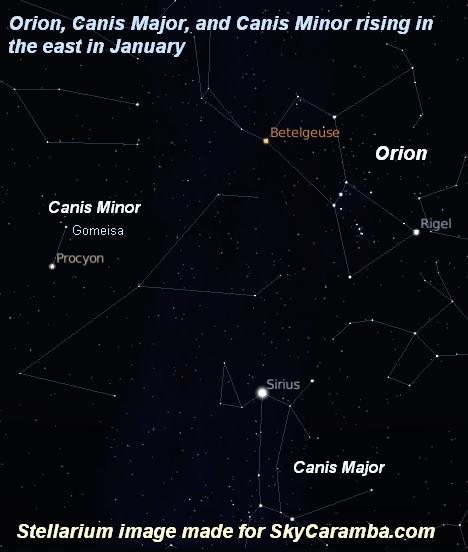SkyCaramba weekly astronomy blog for the week ending January 21, 2012
You’ve probably heard of the dog days of summer. Winter has some dog nights. When Orion rises in search of game on cold winter evenings, his two hunting dogs aren’t far behind. I don’t know what he’s hunting, but he doesn’t need the dogs to go first. Orion’s dogs are Canis Major and Canis Minor, the Big Dog and the Little Dog, respectively.
 The Big Dog’s brightest star is Sirius. It’s the brightest star in our sky if you’re not counting the sun. You’ll see its blue glow sparkling a little behind Orion. While it’s such a prominent winter constellation for those in the northern hemisphere, Sirius is actually the star associated with the “dog days” of summer. In ancient times, its appearance in the east at dawn was said to have influence dogs to summer madness now often thought to have been actually caused by rabies. Over the course of the fall and winter, the star rises earlier and earlier until it’s up overnight this time of year.
The Big Dog’s brightest star is Sirius. It’s the brightest star in our sky if you’re not counting the sun. You’ll see its blue glow sparkling a little behind Orion. While it’s such a prominent winter constellation for those in the northern hemisphere, Sirius is actually the star associated with the “dog days” of summer. In ancient times, its appearance in the east at dawn was said to have influence dogs to summer madness now often thought to have been actually caused by rabies. Over the course of the fall and winter, the star rises earlier and earlier until it’s up overnight this time of year.
Sirius is a little under nine light years away. It and another star orbit each other every 50 years. The other star, Sirius B, was known to exist for about two decades before anyone had a telescope good enough to see it. The main star, Sirius A, moved in an unusual way just enough to be noticed with the optical instruments astronomers had in mid 1800s. A mathematician analyzed measurements of the movement, used his insight and knowledge of calculations, and helped astronomers conclude there must be another star tugging on it with its gravity.
Before the Big Dog rises, you can see the dimmer Little Dog. Its brightest star is Procyon, which literally means “before the dog”. This might leave the impression that it’s not supposed to be a dog at all. The star’s name refers to the fact that it rises before Sirius. Canis Minor almost isn’t a constellation at all. Just two stars are considered to be the traditional constellation. Of course, the modern constellation boundaries approved by the International Astronomical Union in 1930 contain many more stars.
Procyon is 11 light years away and is the eighth brightest star in the night sky. Not much farther than Sirius, its intrinsic brightness isn’t nearly as much. Intrinsic brightness is a way of comparing how bright different stars would look from the same distance.
Procyon is also a double star. Its double was first seen near the end of the 19th Century. The two stars are so close together, today’s astronomers consider Procyon a difficult double to see. The companion, Procyon B, orbits Procyon A in about 40 years. It’s rather small as stars go. It may be just 1.3 times the size of Earth!
Brazil has made a place for several stars on its flag. Procyon is one of them.
The other star in Canis Minor is Gomeisa. The name means “little bleary eyed one”. The name may refer to a legend of this star representing a woman crying.
My apologies to anyone from the southern hemisphere who objects to referring to this time of year as winter. I hope you’ll indulge as I play with words for effect.
Links to more web sites about these two celestial dogs:
http://www.universetoday.com/19780/canis-major/
http://starryskies.com/The_sky/constellations/canis_minor.html
http://en.wikipedia.org/wiki/Flag_of_Brazil
http://www.solstation.com/stars/procyon2.htm
http://stars.astro.illinois.edu/sow/gomeisa.html
http://www.skycaramba.com/blog/2011/01/23/sirius-things-to-consider/